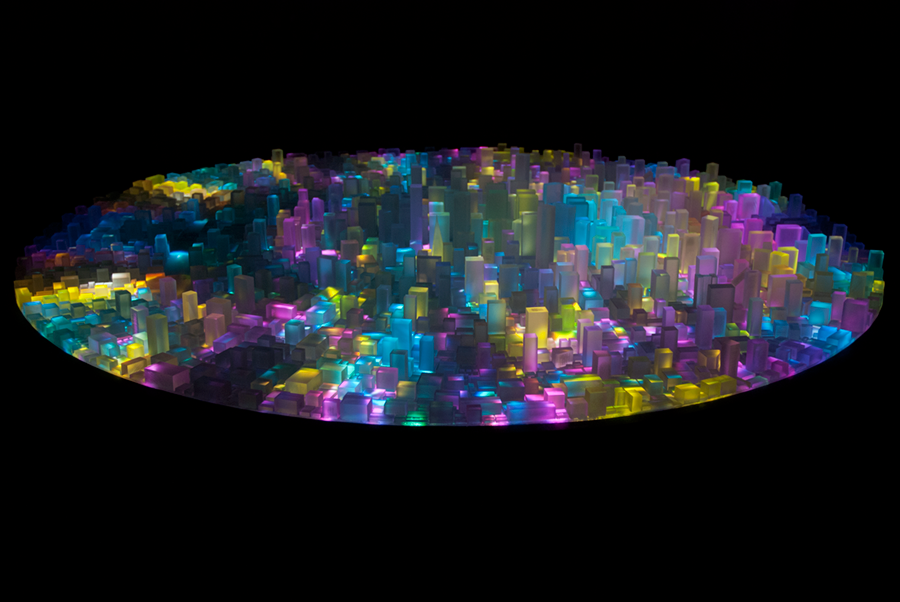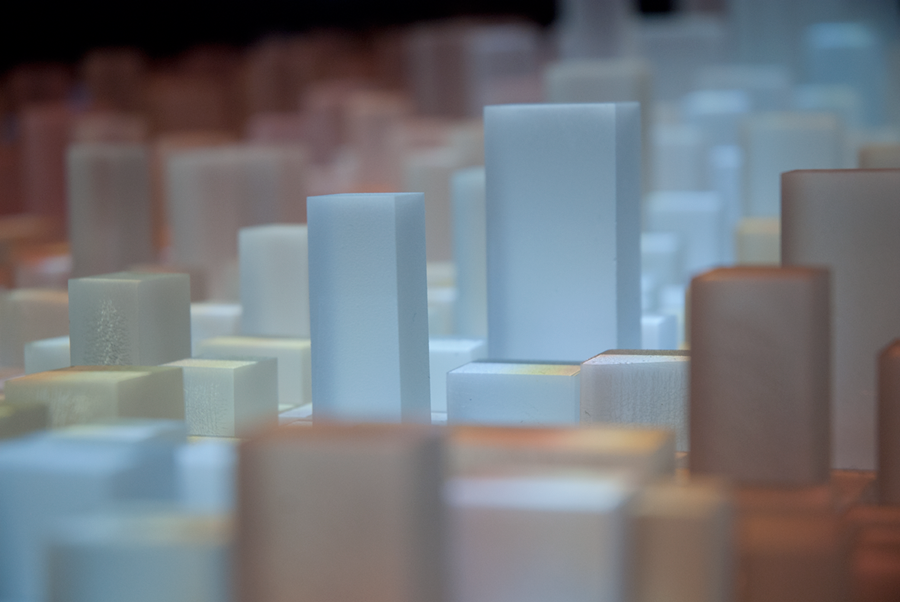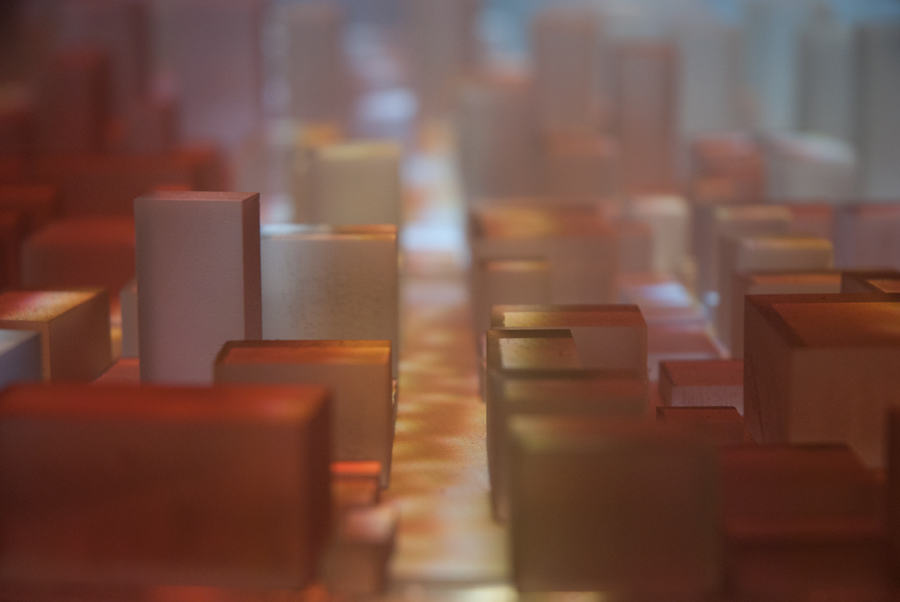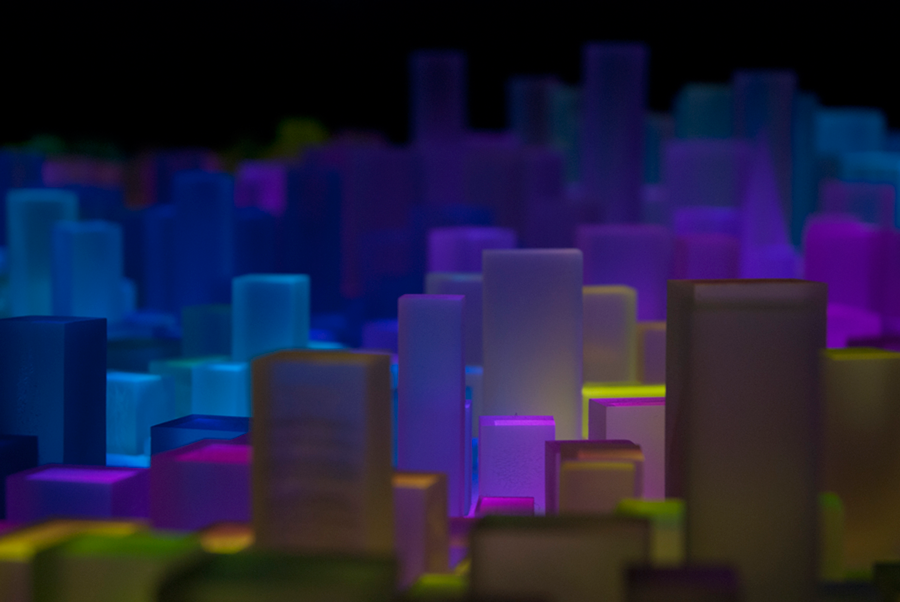Hello, world, 2012
Hello, world, 2012, perspex, pvc, mdf, projector, code
Code written by Ilze Briede (Kavi) and Adam Jaggard
‘The visible world is no longer a reality and the unseen world is no longer a dream’ (Yeats). ‘Hello, world’ explores a new type of urban tissue, the silicon, saturated, invisible world of the online, creating tensions between reality and the virtual. The urban and virtual space are intrinsically intertwined, as Tim Berners-Lee proclaimed the Internet is ‘almost like a mirror to society. It reflects who we are’. The synthetic city blocks are overlaid by mechanical programming language, creating a tension between artifice and reality. The coding reveals itself through its randomness but also its sameness. Even though there is no logical narrative, the computer creates a loop, and this is evident through its mechanical nature. There are four visual behaviours each of which lights the hyperreal city differently, referencing the artificial lights of an electric city. The hypnotic visuals transport the viewer to another subconscious. The immersive nature of the environment reveals the viewer and incorporates them into the world, their world. The two realities have been reversed, now the real world can be commonly viewed in the virtual but the virtual to be viewed in the physical is a rare phenomenon. ‘Hello, world’ aims to stimulate, hypnotize and distract the viewer to feed our ‘juggler’s brain’ (Nicholas Carr). The fearful apocalyptic premonition of a world solely reliant on technology realises itself when the blackout suffocates the viewer in darkness. This highlights the fragility of human nature and as Baudrillard states, this is a representation of ‘a civilization perhaps as scared to see the lights go out as was the hunter in his primitive night’.
The cargo box which envelops the microcosm acts as a façade to contrast with the high gloss seductive world inside and hopes to reveal to the viewer an invisible unexpected world. It is packaged as a commodity, one ready to consume. Once inside the box the viewer essentially becomes inclusive to the product. The lustrous surface of the high gloss interior can also be read as a comment on the seductive advertising that promotes the excesses of consumerism. The potent smell of plastic and the synthetic in the commodity is intoxicating and overpowering, emphasizing the sense of being in an unnatural environment. The mirror references an intangible world, a place where a simulation of the viewer is presented. The circle made by the union of the mirror and the semicircular city is an important feature, it encapsulates the geometric shapes and is a representation of a natural shape and form. These two shapes the geometric and the natural represent the continuous conflict between culture and nature which is another underlying theme within the work. The immersive self-constructed environment is a hollow empty void, which when unplugged is no longer visible and therefore no longer physically real. There is little or no sound, except for a slight hum of the projector which reminds the viewer of the technological presence. It is advisable that the viewers enter the installation singularly, to heighten the sense of alienation and the lack of human interaction that we experience in the Twenty-first Century. This unsettling sensation becomes apparent when the work is placed in a gallery context with noises of other people from outside the box. The viewer literally becomes detached from others and the physical world which surrounds them, and enters a new reality.
‘Hello, world’ references the multiplying amount of hyperreal cities like Dubai and Las Vegas spreading across the world; places which grew out of the artificial rather than the real. All we have now are simulations of reality, which aren’t any more or less ‘real’ than the reality they simulate. The existence of the virtual has become increasingly common in the first world as we spend increasingly more of our lives in an invisible place. Realities are difficult to determine, it can be said that what you can touch is real, what you can see but not touch is virtual, and what you can neither touch nor see is imaginary. However in the Twenty-first Century all these different realms merge and intertwine making the real less real and the virtual and imaginary more real. ‘Hello, world’ presents a near-future place in which virtual reality has become both the basis of entertainment and the more significant part of life for most of the population, suggesting we are surrounded by a dream world, a hyperreality, no longer based on anything identifiably real.
All rights reserved.
© 2025 Lola Lazaro Hinks











